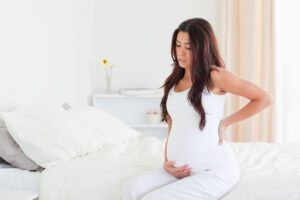 Lower back pain is an ordinary side effect that comes with pregnancy. Its severity varies and can affect your daily life. The pain typically resides once the pregnancy is over. Continue reading below to find out more information about back pain during pregnancy.
Lower back pain is an ordinary side effect that comes with pregnancy. Its severity varies and can affect your daily life. The pain typically resides once the pregnancy is over. Continue reading below to find out more information about back pain during pregnancy.
Lower back pain during pregnancy is quite common. Pregnant people might experience localized pain of the low back that radiates into the buttocks and legs. It may mimic sciatica—pain that radiates along the sciatic nerve that stretches from the low back through the hips and buttocks down the leg. Sciatic nerve pain usually affects only one side of the body. Lower back pain during pregnancy can be constant or it can worsen with activity. It might interfere with sleep and affect a pregnant person’s quality of life. For most people, symptoms will resolve after the birth of their child. Unfortunately, some may experience chronic pain that remains after childbirth. This pain usually starts in the second trimester, but it is possible to experience it earlier than that. Learn more about lower back pain during pregnancy, including signs and symptoms, causes, and treatment.
Frequency and When It Presents
Research shows that around 50% of people who are pregnant will experience low back pain during pregnancy or in the postpartum period. Low back pain during pregnancy can be mild or associated with specific activities. For some people, it can be chronic—that is, pain is persistent and lasts more than three months. One-third of pregnant people will suffer from severe low back pain that reduces their quality of life, while 10% report that low back pain affects their daily routine and ability to work. For most people, low back pain starts between the fifth and seventh months of pregnancy, but for some, low back pain may occur earlier.
Symptoms
You may experience lower back pain at any time during your pregnancy. Symptoms might include:
- A dull or sharp ache or burning pain in the lower back.
- Pain on one side of the lower back.
- Foot drop: This is the inability to lift the front part of the foot while walking.
- Pain similar to sciatic nerve pain radiating into the thigh and leg: These symptoms are more common if there is lower lumbar nerve impingement due to any number of conditions, including herniated disc, muscle strains, or muscle spasms.
- Lower back pain with lying down and sleeping: Lower back pain that gets worse at night is related to an expanding uterus putting pressure on the vena cava—a major blood vessel—and blood vessel congestion in the pelvis and low back.
Causes
The causes of lower back pain in pregnancy are considered multifactorial. This means that different things are affecting various body structures in the lower part of the body leading to lower back pain. Many of the causes are recognized and naturally occurring changes during pregnancy, including those related to posture, blood circulation, anatomy, and hormones. Lower back pain during pregnancy is rarely serious or life-threatening.
One theory about lower back pain in pregnancy relates to mechanical instability of the low back in the lumbar spine and pelvis. During pregnancy, the lumbar spine goes through a compensatory process called lordosis, where the spine adjusts to the center of gravity from the increasing pregnancy weight and abdominal enlargement. This process adds excess strain on the lumbar joints, discs, ligaments, and muscles. The psoas muscle of the hip becomes shortened from the compensatory lordosis, further adding to low back pain. People with a history of low back pain or other preexisting back problems seem to have a higher risk for developing lower back pain during pregnancy.
In addition to changes in the body and history of risk, some daily activities during pregnancy can cause unbalanced movements in the spine, pelvis, and hips resulting from naturally occurring changes of pregnancy.
These might include:
- Walking or running
- Rolling over when in bed
- Bending and twisting the spine
- Lifting
- Climbing steps
While rare, some obstetrical conditions, such as miscarriage, ovarian cysts, or uterine fibroids, may cause lower back pain in pregnancy. Lower back pain is also a symptom of urinary tract infection or preterm labor.
Treatment
Treatment of lower back pain in pregnancy will depend on the stage of pregnancy, what has caused the back pain, any aggravating factors, underlying medical conditions, such as diabetes or high blood pressure, and the severity of symptoms, along with the effect on the quality of life.
In determining treatment options, your clinician may evaluate your posture, range of motion, gait (walking) patterns, joint pain, tendon reflexes, and curvature degree in the lower spine.
Treatment goals will include maintaining function levels and reducing discomfort during pregnancy. Treatment often involves physical therapy and exercise, hot and cold therapy, postural correction, making adjustments to make sleep more comfortable, regular stretching, chiropractic care, acupuncture, and stress reduction with meditation.
Physical Therapy and Exercise
Your doctor or a physical therapist can recommend exercises to strengthen your low back and reduce pain. Regular exercise can strengthen the muscles of your low back, boost flexibility, and reduce the stress on the spine.
Safe exercises during pregnancy include walking, swimming, cycling, and low-impact aerobic exercises (i.e., elliptical trainer or stationary bicycling).
Hot and Cold Therapy
Applying heat and cold to your back might help reduce pain and stiffness in your back. Use cold compresses (such as a bag of ice or cold pack) in the painful area for up to 20 minutes a few times a day.
You can alternate between hot and cold. Use a heating pad in the painful area. Always check with your doctor; they will tell you if it is safe for you to use heat and cold therapy while pregnant.
Improve Posture
Avoid slouching to reduce strain on your spine and use proper posture with walking, sitting, and sleeping. Wearing a pregnancy support belt might help with improving posture during pregnancy.
Sleep Adjustments
The best position for sleeping during pregnancy is on the left side because it provides the best circulation for the mother and growing fetus. Lying on your back can lead to all sorts of problems, including back pain.
It is also helpful to sleep with one or both knees bent and to use pregnancy support pillows between your knees, behind your back, and under your growing belly.
Regular Stretching
Talk to your doctor or physical therapist about safe stretching exercises you can do to strengthen your back and pelvic muscles.
Chiropractic
Done correctly, chiropractic spinal adjustment can be safe during pregnancy. You should check with your healthcare professional if it is safe for you to seek out chiropractic care.
Acupuncture
Studies have found acupuncture to be effective in relieving low back pain during pregnancy. Acupuncture is a type of Chinese medicine that uses thin needles inserted in the skin at certain locations of the body. Check with your doctor before seeking out acupuncture while pregnant.
Stress Reduction
Meditation is a stress-reduction technique that can be utilized at any time and in any place. There are many ways to practice meditation. One of the easiest ways to meditate is to sit or lie down in a quiet place and focus on your breathing. You can meditate in silence or make use of an audio program.
Meditation has been shown to promote a biological relaxation response that stimulates the brain to reduce the release of stress hormones, which in turn reduces muscle tension and pain.
Choosing Safe Pain-Relieving Medications
All medications should be used with caution during pregnancy to reduce the risk of harm to the growing fetus. Fortunately, there are some medications that are safe to use during pregnancy.
For lower back pain in pregnancy, acetaminophen is considered safe and is often given as a first-line drug to treat all types of pain during pregnancy.
You should always consult with your doctor before starting any medication, including supplements, vitamins, and over-the-counter (OTC) medications, while pregnant.
When To Call Your Doctor
While some low back pain and discomfort are normal during pregnancy, there will be instances where you should reach out to your obstetrician or another healthcare professional.
Contact your healthcare professional for the following low back symptoms:
- Any severe pain in your back
- Low back pain that lasts more than two weeks
- Low back pain accompanied by abdominal cramping that gets gradually worse
- Pain or other difficulties with urinating
- Numbness or tingling in the legs
- Vaginal bleeding
- Any abnormal vaginal discharge
- Fever and/chills
These symptoms are concerning and require immediate medical attention. Back pain in pregnancy might be a sign of preterm labor or a urinary tract infection. If back pain is accompanied by vaginal bleeding, fever, or burning with urination, you should reach out to your doctor right away.
Original article posted on verywellhealth.com







